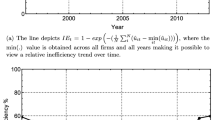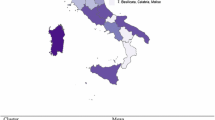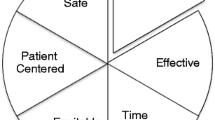Abstract
Renewed debate over competition in healthcare suggests that greater specialization is good for the health economy. In essence, greater specialization is hypothesized to lead to lower average costs, due to learning curve effects, scale, or other operating efficiencies. This hypothesis was tested in oncology care, since this disease group is one of the few with existing specialized cancer centers already in place. Data envelopment analysis (DEA), and specifically a longitudinal Malmquist index over a 5-year period was applied to the major, specialized inpatient cancer centers to determine if these specialized centers achieve higher productivity over time, and if scale leads to higher operating efficiency. Results suggest policy and payer implications since these DRG-exempt hospitals may not be improving their technical efficiency over time. Despite advancements in technology and greater scale, the average efficiency of cancer care has marginally declined. Similarly, when compared to other hospitals with greater numbers of other service offerings, oncology care has not benefited from increasing returns to scale.



Similar content being viewed by others
References
Porter M, Teisberg EO (2006) Redefining health care: creating value-based competition on results. Harvard Business School Press, Boston
Autry P, Thomas D (1986) Competitive strategy in the hospital industry. Health Care Manage Rev 11(7):7–14
Dranove D, Shanley M, Simon C (1992) Is Hospital competition Wasteful? Rand J Health Econ 23(2):247–262
Dranove D, Satterthwaite M, Sindelar J (1986) The effect of injecting price competition into the hospital market: the case of preferred provider organizations. Inquiry 23:419–431
Lesser C, Ginsburg P (2006) Strategies to enhance price and quality competition in health care: lessons learned from tracking local markets. J Health Polit Policy Law 31(3):557–567
Federal Trade Commission (2004) Improving healthcare: a dose of competition. FTC, Washington DC
Arrow K (1993) Agency and the welfare economics of medical care. Am Econ Rev 53:941–973
Enthoven A (2003) Market forces and efficient health care systems. Health Aff 23(2):25–27
Commission on Cancer (2008). American College of Surgeons. Membership details from organization website accessed February 2, 2008.
National Cancer Institute (2008) Comprehensive cancer center listings. National Institutes of Health, Bethesda, Maryland
Centers for Disease Control (2007) Deaths: final data for 2004. Natl Vital Stat Rep 55(19):8–27 August 21
Agency for Healthcare Research and Quality (2006) Medical expenditure panel survey data. Accessed via AHRQ website in January–February 2007
Bureau of Labor Statistics (2007). U.S. Department of Labor. CPI tables accessed in January 2008 from http://www.bls.gov
CMS (2007). Medicare PPS Excluded Cancer Hospitals. List of providers obtained via internet website (http://www.cms.hhs.gov) on January 20, 2008
Vanchieri C (1991) Handful of cancer centers exempt from prospective payment system. J Natl Cancer Inst 83(13):907–908
Porter M, Teisberg EO (2007) How physicians can change the future of health care. J Am Med Assoc 297(10):1103–1111
Ramanathan R (2003) An introduction to data envelopment analysis. Sage, New Delhi
Ozcan Y (2007) Health care benchmarking and performance evaluation: an assessment using data envelopment analysis. Springer, New York
O’Neill L (1998) Multifactor efficiency in data envelopment analysis with an application to urban hospitals. Am Econ Rev 1(1):19–27
Ozcan YA, Luke RD (1993) A national study of the efficiency of hospitals in urban markets. Health Serv Res 28(6):719–739
Ozgen H, Ozcan YA (2004) Longitudinal analysis of efficiency in multiple output dialysis markets. Health Care Manage Sci 7(4):253–261
Althin R (2001) Measurement of productivity changes: two Malmquist index approaches. J Prod Anal 16(2):107–128
Semenick A, Ila M (2001) A nonparametric approach for assessing productivity dynamics of large U.S. Banks. J Money Credit Bank 33(1):121–139
Mohamad N (2004) Productivity growth in the Malaysian mobile telecommunication industry. IIUM J Econ Manag 12(2):1–27
Camanho AS, Dyson RG (2006) Data envelopment analysis and Malmquist indices for measuring group performance. J Prod Anal 26:35–50
Thanassoulis E, Boussofiane A, Dyson RG (1996) A comparison of data envelopment analysis and ratios as tools for performance assessment. Omega Int J Manag Sci 24(1):229–244
American Hospital Association (2007) Trendwatch Chartbook 2007: trends affecting hospitals and health systems. AHA, Chicago
Rosko MD (2001) Cost efficiency of U$S$ hospitals: a stochastic frontier approach. Health Econ 10(1):539–551
Holder A (2004) Radiotherapy treatment design and linear programming. In: Brandeau ML, Sainfort F, Pierskalla WP (eds) Operations research on health care: a handbook of methods and applications. Kluwer, Boston, pp 741–774
Batenburg KJ (2005) An evolutionary algorithm for discrete tomography. Discrete Appl Math 151:36–54
Research Triangle Institute (2007) U.S. News and World Report America’s Best Hospitals, 2007th edn. RTI International, Research Triangle Park, N.C.
Author information
Authors and Affiliations
Corresponding author
Rights and permissions
About this article
Cite this article
Langabeer, J.R., Ozcan, Y.A. The economics of cancer care: longitudinal changes in provider efficiency. Health Care Manag Sci 12, 192–200 (2009). https://doi.org/10.1007/s10729-008-9079-2
Received:
Accepted:
Published:
Issue Date:
DOI: https://doi.org/10.1007/s10729-008-9079-2




